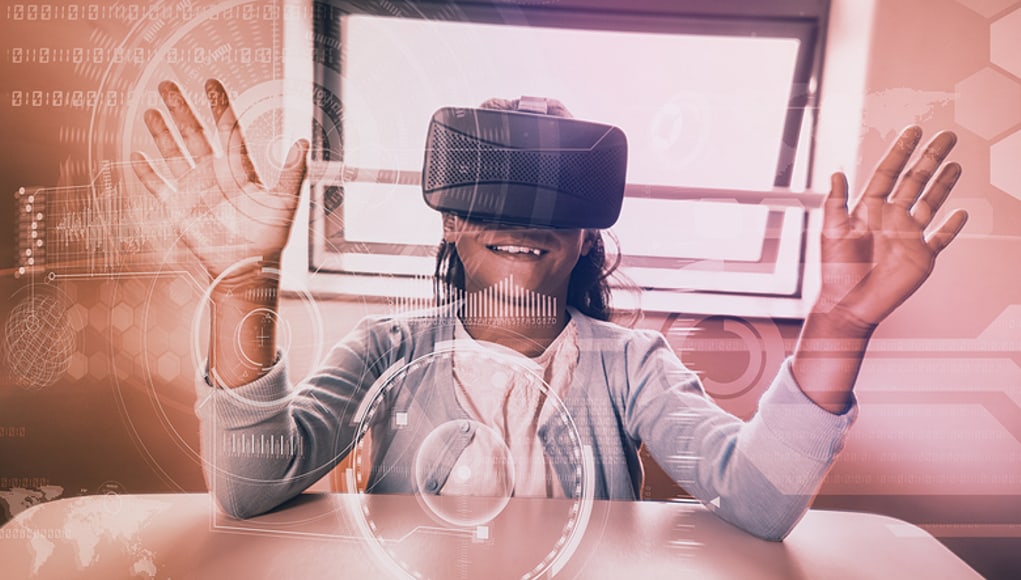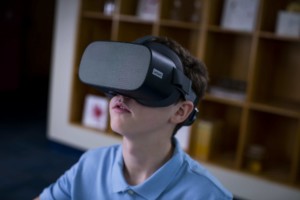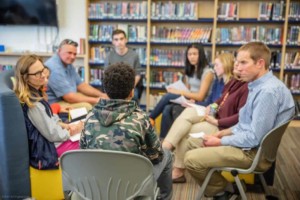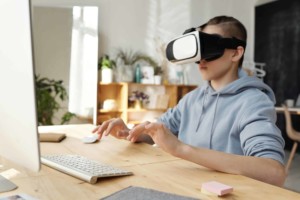Virtual Reality in the Classroom is Becoming the New Norm

By Rae Steinbach
Virtual Reality (VR) has been making great strides in the marketplace in the past year, and it is expected to expand significantly in the next decade. To date, the limiting factor has been the size and cost of headsets that have kept the technology out of reach for the general consumer.
Unlike artificial intelligence, VR comes with the impetus that a wearable piece of hardware is necessary. That’s why, compared with AI innovations like chatbot tools and Google Translate, VR products still have not become widely used.
In 2017, those issues began to change as tech companies released headsets in more affordable price ranges. Oculus Rift, Facebook’s VR headset, has been hitting price points around $400, while Google has produced Google Cardboard, their own version of a headset made of cardboard for as little as $10. The quality of the VR experience varies, naturally, but the affordability has opened the door for experimentation and introducing the technology to a wider audience, including students in classrooms.
Educational Institutions Are Already Exploring VR
From early education to graduate level programs, VR has been providing new learning experiences.The educational community has embraced VR with enthusiasm, with applications ranging from virtual field trips to hazard training.
The Arlington Science Focus School in Arlington, VA, for instance, has been working in conjunction with Baltimore start-up, Alchemy Learning, to develop virtual field trips. Students, wearing the Oculus Rift headset, can explore the Amazon without leaving home, taking photos of animals while learning about them and their habitat.
Google, meanwhile, has developed an extensive library for their Google Expeditions program, which provides virtual tours of physical locations and educational materials for most school subjects. In addition, it incorporates fun experiences with education, like rock climbing, viewing the Aurora Borealis, or venturing into space.
The educational possibilities do not end with high school. Case Western Reserve University is using VR for medical training, assisting instructors on techniques such as catheter insertion. A further benefit is the opportunity for distance learning, providing the same experience to students in various locations.
Several companies are moving into the prospective student space. College campus tours can now be accessed with VR tech in real time. Companies like Georama are bringing the college experience directly to the potential student through virtual tours and live interactions.
The uses for VR are not limited to passive viewing experiences, either. The design field is already using VR to visualize ideas and plans in 3-dimensional, immersive environments. Students and professionals can see their plans come to life, observe advantages and disadvantages to their ideas, and adjust them in real-time.
The Future Is Now
While VR technology has far to go, it is already here for the taking. Educators and entire educational systems can potentially overturn outdated teaching methods and usher in a new era of personalized learning.
With the world focusing on and analyzing more and more data as an intrinsic means for improvement, VR offers the opportunity to cross cultural boundaries, discover new pedagogical approaches, and revolutionize the classroom.
For more, see:
- 7 Top Virtual Reality Education Apps
- 12 Digital Tools to Try in 2018
- How Virtual Reality and Embodied Learning Could Disrupt Education
Stay in-the-know with all things EdTech and innovations in learning by signing up to receive the weekly Smart Update.






David Miller
Oculus Rift, Facebook’s VR headset, has been hitting price points around $400, while Google has produced Google Cardboard, their own version of a headset made of cardboard for as little as $10.
big boy ben shapiro
Studies show that VR doesn't help with productivity and becomes more distracting than educational. fake news.
vr melbourne
I think that in the future, virtual reality technology can be actively used in study. Such lessons will be much more effective than "classical" lessons. Since this technology allows you to create various simulations. This will allow for a real example to show physical or chemical processes. You can also simulate the work of invisible elements. For example, the processes that occur in the human body. In addition, it will be possible to recreate historical events or historical buildings in order to visually study this subject. Therefore, this technology can be very effective in study. The only one thing that limits using this technology in study now is a cost of equipment for virtual reality.
VUZ
Virtual Reality (VR) is improving more these days. It used to be too pricey, but now there are cheaper versions available. Schools are starting to use VR for learning, like going on virtual field trips. Even colleges are using it to train students in medicine. Some companies are using it to give virtual tours of colleges. And it's not just for watching stuff, people are using it to design things too.